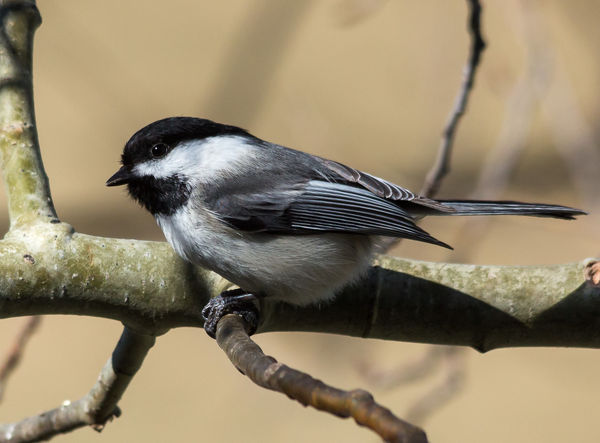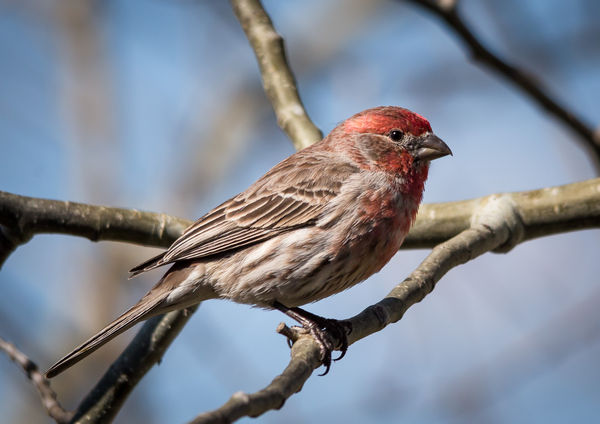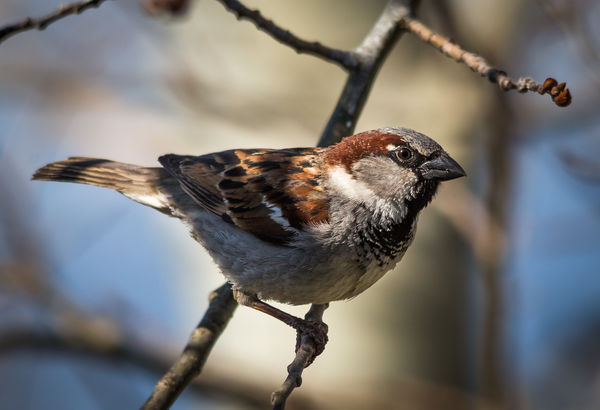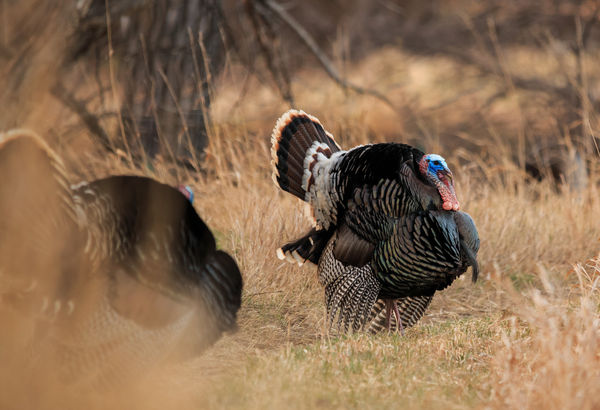OS/IS/VR Again (Still)
Apr 21, 2015 09:18:20 #
I have followed this discussion for some time here, read about it elsewhere, and am still in a quandry as to a solid direction. Some Pros (well published and successful) state uncategorically to leave OS on at all times (including on tripod). Others here and elsewhere suggest the opposite. I have included a simple test that I conducted, which (in my opinion) is completely inconclusive. Would other factors contribute to OS success or impact (i.e. distance to subject)? This is primarily with regards my Sigma 150-500, which I have very poor sharpness success off tripod regardless of which OS level I have set.
These were shot on tripod (with Gimbal), remote shutter, no wind, PP'd about the same, cropped about the same, ISO the same, Fstop the same. The shutter speed difference is due to minor differences in where the birds landed in the tree. Canon 6D. Does anybody see something that I am not seeing here, as frankly, they look pretty much the same to me.
These were shot on tripod (with Gimbal), remote shutter, no wind, PP'd about the same, cropped about the same, ISO the same, Fstop the same. The shutter speed difference is due to minor differences in where the birds landed in the tree. Canon 6D. Does anybody see something that I am not seeing here, as frankly, they look pretty much the same to me.
Apr 21, 2015 09:32:55 #
I have no experience with Canon since I have used Nikon cameras and lenses since 1963.
Nikon has two VR types of lenses, the old VR and the new VR II. I am more familiar with the old VR type.
Nikon recommends to keep VR off while the camera is on a tripod. The images with the old VR type tend to get soft if VR is on while camera is on a tripod. I am not familiar with the new VR or VR II but it is my understanding that Nikon still recommends VR off with his latest VR while camera is on a tripod.
VR DOES NOT eliminate movement by the subject it does eliminate movement by the operator's hand. If the shutter speed is higher than the used focal length of the lens VR is not necessary and to repeat myself, VR is only useful for stationary subjects.
I have used my 80-400 VR lens with moving subjects without ill effects. It is the tracking of the AF system that keeps those moving subjects under control if the shutter speed is high enough. In a case like that VR contribution is only to use more juice.
Hopefully this will help you understand and I am sure others will help you even more.
It seems as if your last shot is the sharpest to my eyes.
Nikon has two VR types of lenses, the old VR and the new VR II. I am more familiar with the old VR type.
Nikon recommends to keep VR off while the camera is on a tripod. The images with the old VR type tend to get soft if VR is on while camera is on a tripod. I am not familiar with the new VR or VR II but it is my understanding that Nikon still recommends VR off with his latest VR while camera is on a tripod.
VR DOES NOT eliminate movement by the subject it does eliminate movement by the operator's hand. If the shutter speed is higher than the used focal length of the lens VR is not necessary and to repeat myself, VR is only useful for stationary subjects.
I have used my 80-400 VR lens with moving subjects without ill effects. It is the tracking of the AF system that keeps those moving subjects under control if the shutter speed is high enough. In a case like that VR contribution is only to use more juice.
Hopefully this will help you understand and I am sure others will help you even more.
It seems as if your last shot is the sharpest to my eyes.
Apr 21, 2015 09:39:30 #
I can't see much difference either. They all would be acceptably sharp to me. The OS2 one looks a little more sharpened ... could that be?
Apr 21, 2015 10:45:41 #
JTEEE, seems like this topic frequently ends up going somewhat along the lines of RAW vs. jpeg, Canon vs. Nikon, etc. You'll probably end up with 1/3 responses to leave it on, 1/3 responses to turn it of and 1/3 arguing about whether you used the right tripod or even needed a tripod.
The real answer is going to end up being: What works best for you? The best thing to do is just what you did - take some test shots, compare them, see what looks best. A lot of this is going to come down to how steady you can keep the camera/lens combo during the shot, and that is going to be different from photographer to photographer; so no matter what, you're going to get conflicting answers.
The pictures you showed above all look just fine. Another test you may want to perform is how well the OS performs as you take Bird In Flight pictures. Liable to see big difference there.
The real answer is going to end up being: What works best for you? The best thing to do is just what you did - take some test shots, compare them, see what looks best. A lot of this is going to come down to how steady you can keep the camera/lens combo during the shot, and that is going to be different from photographer to photographer; so no matter what, you're going to get conflicting answers.
The pictures you showed above all look just fine. Another test you may want to perform is how well the OS performs as you take Bird In Flight pictures. Liable to see big difference there.
Apr 21, 2015 12:00:29 #
camerapapi wrote:
I have no experience with Canon since I have used ... (show quote)
Thanks for your reply. Actually you pointed out one point that I keep failing to embed in my feeble brain, and that is that (according to some anyway) OS does not come into play on photos with faster shutter speed than focal length. Which all three of these had (I believe they were in the 1/1400 range with focal length of 500). That would pretty much render my little test irrelevant.
Apr 21, 2015 12:02:27 #
Picdude wrote:
JTEEE, seems like this topic frequently ends up go... (show quote)
Thanks for your response, and I agree. BIF is next on my list, but as I mentioned, I seem to have limited success with this camera/lens combo on BIF. Hopefully I just need more practice.
Apr 21, 2015 12:03:53 #
RJNaylor wrote:
I can't see much difference either. They all would be acceptably sharp to me. The OS2 one looks a little more sharpened ... could that be?
They were all PP'd pretty much the same, but I agree. It may have just been the way the light hit the birds head to make it more noticeable?
Apr 21, 2015 12:34:48 #
I use the OS1 setting with that lens on a Nikon mount and it works out well hand-held out to about 400mm. You always lose some sharpness when you push zooms to the max. Plus, that lens doesn't have a very large aperture fully extended. I prefer to walk around and do hand-held shots, that lens keeps you in shape! I can do a little longer and sharper on a tripod, but that's to be expected.
Apr 21, 2015 13:14:41 #
jteee wrote:
I have followed this discussion for some time here... (show quote)
Jerry, the deciding difference is the shutter speed at which you are shooting. If your shutter speed gets to or above 1/1000 sec, it does not seem to matter whether the stabilization is on or off. I have done several tests over the last couple of years and the place it seems to make the most difference is when you get down to shooting around 1/250 sec or slower. At that point the stabilization will almost always blur the image when using a lens that is not "tripod aware". This seems to be the case regardless of lens manufacturer as I have gotten the same results with Sigma, Tamron, Nikon and Canon lenses.
Apr 22, 2015 09:05:58 #
MT Shooter wrote:
Jerry, the deciding difference is the shutter spee... (show quote)
Thanks Carter. That input is very helpful, as I think that I have inadvertently validated your tests!LOL I had been leaving the Sig on OS1, and this shot was at 1/160 (tripod, gimbal, remote release), and the sharpness is unacceptable to me. As close as the subject was, it should have been better. I think that I had erroneously blamed that on ISO 1600 (probably contributed some, but not the amount you see). thanks again, you've put me on a different path.
Apr 22, 2015 12:35:29 #
My understanding is that whichever method you use, the primary difficulty is speed to focus... not loss of focus capability.
I read that having the IS/VR whatever on while on a tripod and considering the focal length point, IS/VR will hunt for shake, and in the case where the tripod is holding the camera stable, finding no shake will result in a bit more time to "lock" focus.
May NOT make a difference where you are waiting on a relatively static subject to lock focus and OK with the time taken for focus confirmation, you may not be so patient on BIF.
I thought from comments on the forums that most manufacturers have spoken to this in their manuals. Maybe not. I have not read every digital camera manual for every camera with VR/IS....
It's on my bucket list. (Bucket List-things I hope to do before I die, or things that will kill me while attempting them!)
I read that having the IS/VR whatever on while on a tripod and considering the focal length point, IS/VR will hunt for shake, and in the case where the tripod is holding the camera stable, finding no shake will result in a bit more time to "lock" focus.
May NOT make a difference where you are waiting on a relatively static subject to lock focus and OK with the time taken for focus confirmation, you may not be so patient on BIF.
I thought from comments on the forums that most manufacturers have spoken to this in their manuals. Maybe not. I have not read every digital camera manual for every camera with VR/IS....
It's on my bucket list. (Bucket List-things I hope to do before I die, or things that will kill me while attempting them!)
Apr 23, 2015 21:57:24 #
Maybe try all this - it MIGHT help you answer your question.
First off, use your SHARPEST lens, at its 'sweet spot' and determine when your photos start to suffer due to high ISO. Note that value. I'll call it ISO-max.
Now, find the 'sweet spot' - lens opening & zoom focal length - for your Big Sig, not exceeding your ISO-max. Be sure to use a short enough shutter speed so not to have camera movement. Shoot a fixed object to avoid subject movement.
Now that you've found the 'best' lens opening & zoom, and your ISO-max, choose a fairly short shutter speed that you KNOW will stop your camera movement - maybe 1/2000 - when you hand hold your camera. Do not use the VR feature. Increase your exposure times until your photos show camera movement. Let's say this works out to 1/500.
Do this again, using VR. Let's say that VR will allow you to hand hold your camera & lens at 1/350.
Now, use your tripod & make a series of shots using VR, use longer & longer shutter exposure and see if VR actually DOES cause camera movement. Lower your ISO & maybe even use ND filters to allow exposures up to, oh maybe, 1/4 second.
Now, to determine IF VR actually does cause camera movement with a tripod. . . turn off the VR & make another series of long exposures.
Lots & LOTS of work. . . and you'll learn the MAX-iso, the 'sweet spot' of your lens(es), your maximum hand-held shutter speed, AND if VR 'helps' or 'hurts' while using a tripod - all that work for you, the way you like your photos.
Good luck!
First off, use your SHARPEST lens, at its 'sweet spot' and determine when your photos start to suffer due to high ISO. Note that value. I'll call it ISO-max.
Now, find the 'sweet spot' - lens opening & zoom focal length - for your Big Sig, not exceeding your ISO-max. Be sure to use a short enough shutter speed so not to have camera movement. Shoot a fixed object to avoid subject movement.
Now that you've found the 'best' lens opening & zoom, and your ISO-max, choose a fairly short shutter speed that you KNOW will stop your camera movement - maybe 1/2000 - when you hand hold your camera. Do not use the VR feature. Increase your exposure times until your photos show camera movement. Let's say this works out to 1/500.
Do this again, using VR. Let's say that VR will allow you to hand hold your camera & lens at 1/350.
Now, use your tripod & make a series of shots using VR, use longer & longer shutter exposure and see if VR actually DOES cause camera movement. Lower your ISO & maybe even use ND filters to allow exposures up to, oh maybe, 1/4 second.
Now, to determine IF VR actually does cause camera movement with a tripod. . . turn off the VR & make another series of long exposures.
Lots & LOTS of work. . . and you'll learn the MAX-iso, the 'sweet spot' of your lens(es), your maximum hand-held shutter speed, AND if VR 'helps' or 'hurts' while using a tripod - all that work for you, the way you like your photos.
Good luck!
If you want to reply, then register here. Registration is free and your account is created instantly, so you can post right away.









